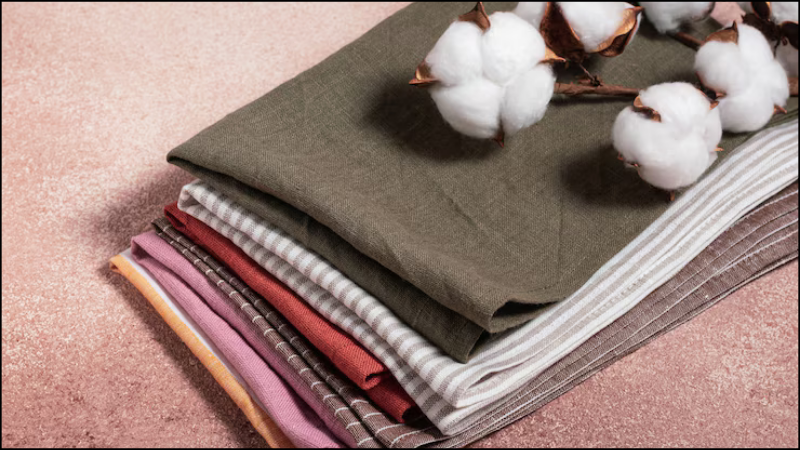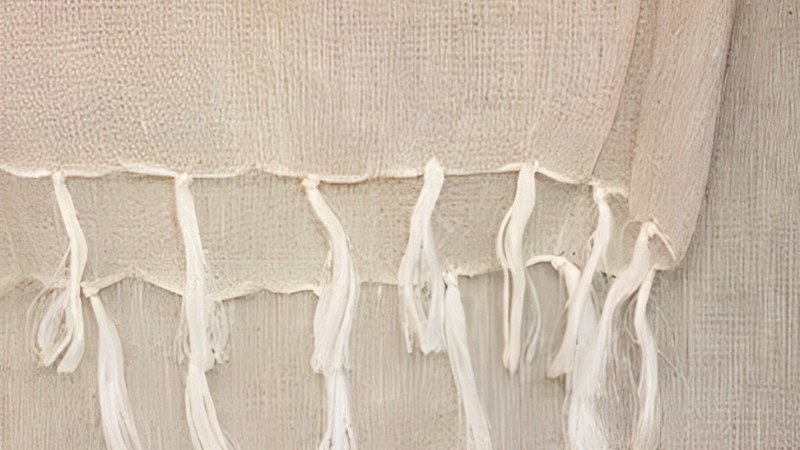A vast range of fabrics is available, but when it comes to relaxation, Comfortable fabrics like cotton and Linen are considered two of the best options. Both cotton and Linen have similar uses, from clothing like tops and dresses to home textiles such as bedsheets, cushions, pillows, and curtains. However, what differentiates these two fabrics from each other? In this article, I will compare Linen and cotton.
Both cotton and Linen are natural fabrics made from plant fibers. While both are suitable for summer wear, cotton is known for its durability, softness, and warmth, whereas Linen is known for its breathability, lightweight, and moisture-wicking properties. If you're faced with a decision between the two, whether you're shopping for fabric for a sewing project or ready-made clothing, read on. I'll outline each fabric's characteristics and pros and cons to make your decision-making process more manageable and accessible.
Cotton
Cotton is a type of fiber that is widely used for making various fabrics. Different types of cotton are available as the fibers come in varying lengths, such as Egyptian cotton or Pima cotton. Cotton can be woven or knitted and transformed into many different fabrics, including muslin, gabardine, denim, and flannel.
Cotton fabric is made by harvesting cotton plants. The seeds are separated from the cotton bolls, and dirt and impurities are removed. The fibers are then separated and spun into long strands of cotton yarn.
Cotton is usually white but can be bleached or dyed to change color after it's spun into yarn for fabric. The type of cotton used determines whether the cloth is woven or knit.
Woven and knit fabrics have specific characteristics such as breathability or stretch.

Linen
Plant fibers create a natural fabric called Linen., specifically flax. It has been used in clothing for centuries and is commonly worn in warmer climates or during warmer months. However, it is less widely used than cotton.
Linen is a long staple fiber, often woven into fabric. Few fabrics are made from it besides the standard ones.
Linen fabric is usually consistent in texture and thickness. Although it is commonly white, linen fibers are naturally grayish-brown.
Flax plants are harvested once they have matured to make linen fabric. The stalks of the plants are used to create the fabric and separated from the leaves and seeds using a machine.
The process of making Linen involves separating the inner and outer fibers of the stalks. The outer fibers are too stiff to make quality linen, so they are discarded.
The fibers are combed into thinner strands and spun into yarn to create fabric. The yarn is then treated by bleaching, dyeing, or other processes. The final step is weaving the yarn together to make the fabric.

Pandi is a wholesaler that prides itself on providing high-quality and versatile fabrics to its customers. One key reason for its popularity is that it offers both linen and cotton fabric. Pandi understands the importance of providing options to its customers and thus offers both linen and cotton fabric with beautiful prints and colours to cater to different preferences and needs. Customers can choose between the two fabrics depending on their style. Pandi's collection has something for everyone.
Breathability
These fabrics are worn in warmer months and are naturally breathable as they are made from plant fibers.
Cotton's breathability depends on how the fibers are woven or knit together. Loosely woven cotton allows for more breathability, while tightly woven cotton is less breathable.
Cotton is less breathable than Linen. Linen is woven more loosely than cotton, and flax fibers are more hollow. Hollow fibers allow air to circulate freely, making the fabric more breathable. When worn, Linen feels breezy.
Durability
Cotton and Linen can last long if cared for properly, but they might shrink when washed. Many cotton fabrics are preshrunk to avoid this issue.
Linen shrinks more than cotton if not washed correctly. Unlike cotton, it's harder to stretch Linen back to its standard size after shrinking.
Cotton is generally more durable than Linen since it has a tighter weave. However, some types of cotton fabric are more durable than others based on their thickness. For instance, denim is thicker than muslin and is thus more durable. On the other hand, Linen is more loosely woven and, therefore, more prone to tearing or snagging.
Warmth
Cotton and linen fabrics differ in terms of warmth. While Linen is not commonly used in fall or winter clothing due to its lightweight structure, cotton can provide warmth depending on the type of fabric. For instance, flannel is made from cotton and is a popular choice for winter wear, such as pajamas and button-up shirts.
Cotton has insulation properties because its fibers are not hollow, making the fabric less breathable. Additionally, it can be made thicker and heavier to provide more warmth.
Linen and cotton are two types of fabrics that are commonly used for clothing. If you need to keep warm, cotton is a better choice because it is typically medium-weight and, therefore, warmer than Linen. Linen is lightweight and has hollow fibers that allow air to circulate, so it is not as warm as cotton. If you plan to layer your clothing, there may be better options than Linen for colder months.
Weight
Cotton fabrics are usually medium-weight, but Linen is lighter due to its hollow fibers and loose weave. While cotton can be versatile and comes in different weights, Linen is a better choice if you want a light and airy feel for your clothes. Muslin is an example of lightweight cotton, while denim or heavyweight cotton has a thicker and tighter weave.
Softness
Cotton is often softer than Linen because its fibers are tightly woven together. However, not all cotton fabrics are equally soft. For instance, fabrics made from Pima cotton or flannel tend to have a smoother texture than regular cotton fabrics.
Due to its loose weave, Linen is not necessarily rough but stiffer than cotton. While Linen feels more airy, cotton is more comfortable on the skin. Due to its texture, linen wrinkles more efficiently than cotton.
Moisture Wicking
If you're looking for clothes to wear in the warmer months, choose fabrics that absorb moisture, like sweat and rain. Cotton is not a good option for this purpose. It can quickly become heavy and uncomfortable when it gets wet. Also, because cotton does not absorb moisture well, it takes longer to dry, making it an awkward choice on hot, humid days.
Linen is more moisture-wicking than cotton because its porous and hollow fibers allow air and water to circulate better. It is also breathable and ideal for hot days. Although it only becomes saturated slowly, depending on how wet it gets, it can still take time to dry.
Ease of Care
Cotton and Linen require similar care as they both shrink quickly. It's essential to wash them before use to prevent slight shrinking. Linen shrinks more than cotton, even in the dryer. Always use the right temperature and dryer setting to avoid further shrinking during subsequent washes.
Linen and cotton should be washed with cold water and air-dried. If it is preshrunk, cotton can be dried in the dryer on low heat. Linen should always be air-dried, as it can shrink in the dryer even on low heat. Both fabrics can wrinkle, but Linen tends to wrinkle more due to its stiffer texture. It is safe to iron both fabrics, but Linen is more likely to wrinkle while wearing them.
Cost
Cotton and Linen are affordable natural fabrics compared to wool or silk. Cotton is the cheapest fabric due to its wide availability and global cultivation.
It is worth noting that the price of cotton fabrics may vary depending on the type of cotton used. For instance, Egyptian or Supima cotton, which is grown in specific regions, can be more expensive than other types of cotton. Additionally, thicker or more delicate cotton fabrics may come at a higher cost than regular cotton fabrics.
Linen is more expensive than cotton due to the limited availability of flax. Flax is mainly grown in temperate climates, and only certain parts of the plant can be used to manufacture Linen, making it more challenging to produce. This, coupled with the need for both growers and manufacturers to create a profit, affects the cost of Linen.
Uses
Cotton and Linen are commonly used for warm-weather clothing. Cotton is more versatile and durable than Linen and is rarely used for winter clothing.
Cotton is a versatile fabric used to make various types of clothes. It is commonly used in T-shirts either alone or blended with other fibers. Cotton is also the primary fabric for denim jeans, leggings, and home textiles like bed sheets, blankets, upholstery, curtains, and more.
In contrast, Linen mainly makes lightweight and breathable clothing such as spring and summer dresses, blouses, pants, and skirts. It is not commonly used for T-shirts because it wrinkles and snags easily. However, Linen's breathability and moisture-wicking properties make it a perfect choice for bed sheets and pillowcases.
Pros and Cons of Cotton
Now that you have learned about the typical characteristics of cotton fabric let's review its advantages and disadvantages. Cotton is very versatile and affordable. It can be used for any sewing project and various kinds of clothing. Additionally, it tends to be a bit warmer and softer than Linen.
Cotton fabric is only sometimes the best option. It is less breathable than Linen and may need to be more moisture-wicking. Cotton is also prone to shrinking, but washing it correctly can easily prevent this. Additionally, it tends to wrinkle easily, but if you take it out of the dryer as soon as possible and hang or fold it, you can reduce the amount of wrinkling.
Pros and Cons of Linen
Linen is a fabric that has some great qualities, but it also has some downsides. One of the good things about Linen is that it is highly breathable. It is also very lightweight and moisture-wicking, which makes it a better fabric to wear in the summertime than cotton. This is one of the reasons why many people love Linen, as it has a very airy feel when worn.
Linen is more expensive than cotton but still cheaper than other natural fabrics. However, it's less durable than cotton so that it can tear or snag easily. Cotton is less prone to wrinkling and shrinking than Linen. To prevent wrinkling and shrinking, it's best to air-dry Linen instead of putting it in the dryer.
Which Is The Better Choice?
When deciding between cotton and linen fabric, the choice depends on what you're looking for in a fabric and what type of clothing you want to make or buy. Both fabrics have unique characteristics, so it's essential to consider what's important to you.
Choosing between cotton and linen fabrics can be a tough decision. However, it can be made more accessible by considering your needs. If you want a fabric that is easier to care for, warmer, softer, and more affordable, cotton is the better choice. On the other hand, if you prefer a more breathable, lightweight, and moisture-wicking fabric, Linen is the better choice, though it may be more expensive and require more complicated care.
In summary, both have advantages and disadvantages; deciding which best suits your needs is up to you. If you found this information helpful, please share it with others and leave a comment below to let us know how we did. Your feedback is highly appreciated. Thank you!













